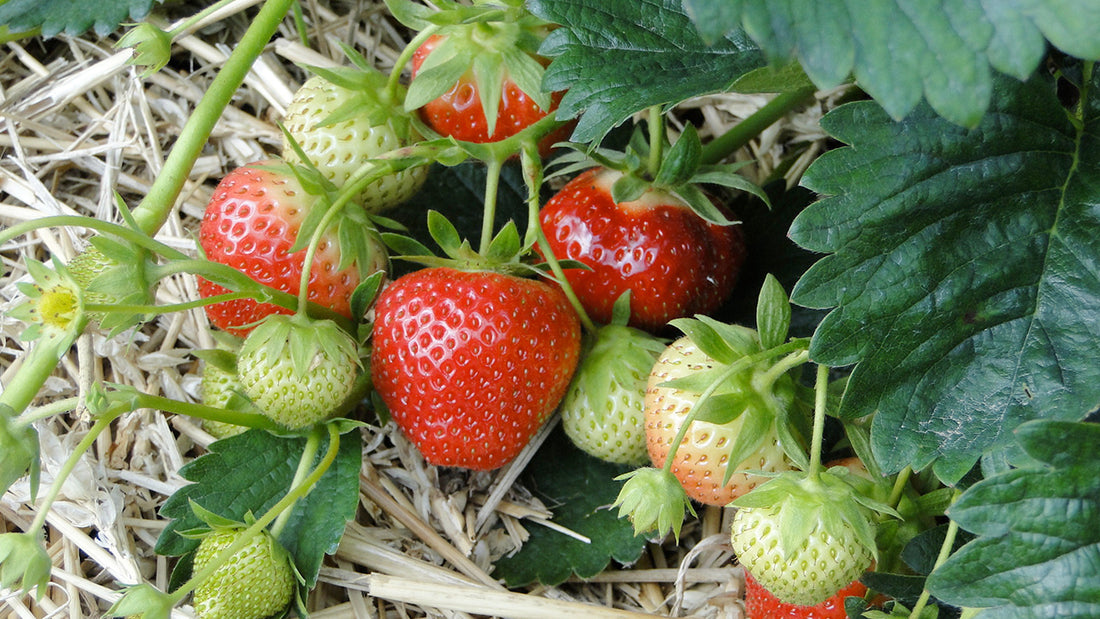Simple steps for planting your strawberries
There’s a cold north wind blowing, rattling the last of the winter-dead leaves on the trees. The skies are grey, threatening another round of sleet or maybe snow. The land, too, is gray, no signs of spring are yet in sight. What better time could there be to bundle up, grab your shovel and plant some strawberries!
Step 1: Select a Variety
All strawberry plants are not created equal. Before you get planting, you’ll need to consider what variety would be best for your garden.

June-bearing:
Strawberries are the most popular and productive varieties. They will yield a big harvest of strawberries in one month-long burst, typically in early summer or late spring beginning the second year after planting. The big once-a-year harvest is especially good if you like to make jams and jellies. Varieties include Honeyoye, Allstar, Eclair, and Chandler.
Everbearing:
Strawberries bear two crops per year, beginning the second year after planting. They are ready to harvest in mid-summer and again in autumn, but with little in between. This harvest cycle is good for preserving and for market gardens. Varieties include Fort Laramie, Quinault, and Ozark Beauty.
Day Neutral:
Strawberries bear from spring to fall. Their total yield is similar to Everbearing, but spread out over the whole growing season. This makes these strawberries best for fresh eating. Varieties include Fern, Seascape, and Eversweet.
Another factor to consider is your climate. Not all strawberry varieties grow well in all regions. For cold areas, Honeyoye and Fort Laramie will over-winter best. For the Inland Northwest and Intermountain West, try Allstar and Quinault. Regions with mild winters and hot summers should choose Chandler, Sequoia or Seascape.
Step 2: Site Preparation
The Soil...Now that you have a plan, it’s time to get your garden ready. Winter is the best time to plant strawberries, as dormant strawberry crowns are quicker and easier to establish than summer transplants. The best time to plant the crowns is when nighttime temperatures remain above 25°F.

Strawberries prefer well-drained, sandy loam that is at least 12 inches deep. However, they are tolerant of most soil conditions so long as the drainage is good. They are also ideal for container gardens and raised beds.
Select a spot in full sun. Strawberries grown in shade will not produce much if any fruit. Prepare your soil to 12 inches deep. For best success, test your soil to find out what fertilizers would help strawberries grown in your soil. The soil should be 5.5 to 7.0 pH, but 6.0 to 6.5 pH is ideal. It should be light and loamy. Strawberry nutrient requirements are the same as standard garden soil, except that they require slightly extra potassium (K). Magnesium (Mg) deficiency is fairly common in strawberries, which can be supplemented with a trace mineral blend such as Cascade Minerals.
The Weeds...Weed control is essential for strawberries. Remove the weeds before planting. Strawberry patches can be very difficult to weed later, and prevention is the best solution. You can mulch with red or silver plastic mulch or a natural mulch, like rice straw, to prevent weeds from regrowing.
Step 3: Planting
There are two common patterns to plant your strawberries. If you will be growing Day Neutral or Everbearing berries, which produce few runners, plant them in a “Ribbon Row” or "Hill Method" 4 – 9" apart in an 18" wide row. If you will be growing June-bearing strawberries, plant them in a “Matted Row” 9 – 18" apart in a 12 – 18" wide row; next year you will allow up to 6 daughter plants to form from the runners and set them evenly spaced around each mother plant. Additional runners should be pruned to encourage heavier fruit set and prevent overcrowding in the beds.
The hole that you plant in should be big enough to hold the roots without crowding. The best depth to plant the crowns is for the settled soil level (after firming and watering) to be half way between the top of the roots and the bottom of the crown bud. Be careful not to plant too shallowly or the roots will dry out easily, and not so deep as to cover the bud.
Step 4: Maintenance

Your strawberries will probably flower in the first year. For June-bearers and Everbearers, pinch the flowers off to encourage stronger roots and healthy growth. As tempting as it is to get a small harvest the first year, your plants will produce more overall if you force them to focus on growing bigger in the first year instead of spending energy on making fruit.
Also keep those runners pruned. In peak season, look for new runners to remove weekly. If the temptation to let them produce more plants is too strong to resist, you can pot the pruned runners in their own new home. Just soak the nodes in diluted liquid kelp overnight, and plant in containers or a newly prepared strawberry patch. Before you know it, you’ll have strawberry plants to give to all your friends and neighbors!
Your strawberries will require adequate irrigation, but be careful not to over water. Drip irrigation is best. If you overhead-water your strawberries, do so in the morning so that the leaves and fruit have plenty of time to dry off by nightfall.
So put your strawberries in the ground now, and a delicious summer harvest will be here before you know it!
For more information on growing strawberries, check out the Peaceful Valley Growing Guide, Cornell University Cooperative Extension, or University of Idaho Cooperative Extension
For more information on growing BIG strawberries organically, see our guide.



6 comments
I planted my strawberries at the end of may this year, and I’m not seeing any progress. I bought a pack of 20 plants but there were only a few with leaves. (When I bought it they said it was 9 plants. If was definitely more) I planted them exactly as you specified, but only the originals with leaves seem to be doing ok. The rest look dead. I thought I didn’t plant deep enough or water enough but now i have no idea. Will I see growth next year? I just tried to cover all the roots and not the head bc I thought they dried out .